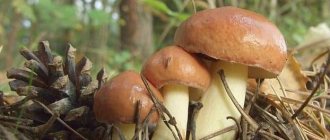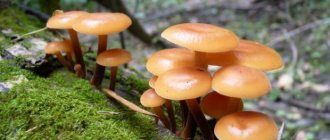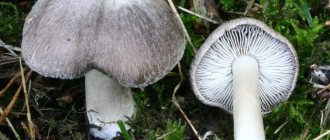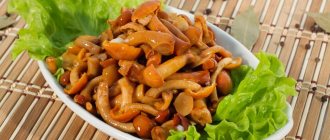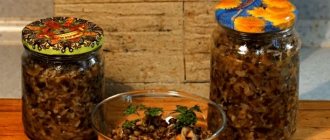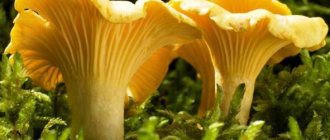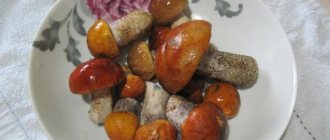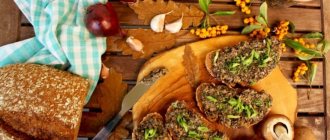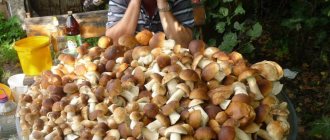Greenfinches are common mushrooms with a dubious reputation. Despite the general opinion about their toxicity and frequent cases of poisoning, these forest gifts remain beloved in many Russian families.
It is believed that proper salting or pickling of greenfinches cannot cause harm to health, but on the contrary, will provide gastronomic pleasure. We suggest you consider how to prepare greens or greens for the winter.
Useful properties, composition, energy value and calorie content
Podzelenki are mushrooms that belong to the genus Tricholoma. Podsosnovniks, mice or serushki - all these are the same edible mushrooms. Their name is Gray Ryadovka (Tricholoma portentosum).
A nondescript gray mushroom, at first glance, looks unappetizing. However, the row has high taste, as well as a number of useful properties:
- antibiotic effect due to the active substances in the fungus - fomycin and clitocin;
- the ability to remove free radicals from the human body and cleanse the liver of toxins;
- anticancer effect;
- stabilization of blood pressure in the body, strengthening of blood vessels;
- elimination of depression, normalization of the nervous system.
REFERENCE! Greens should be included in the diet during periods of exacerbation of ARVI. It is advisable to do this for three months during epidemics.
Gray rower can be called a dietary product, because it contains only 22 calories per 100 g. Nutritional value:
- fats - up to 0.34 g;
- proteins - about 3.09 g;
- carbohydrates - up to 3.26 g.
Mushrooms also contain ash (about 0.85 g) and dietary fiber (about 1 g). Among the vitamins and beneficial microelements, pine trees contain:
- vitamins C, D and group B;
- nicotinic and pantothenic acids;
- choline;
- betaine;
- calcium;
- sodium;
- phosphorus;
- magnesium;
- iron.
Description of primary treatment of sulfur row
Collected or purchased rows should be properly processed. This is a guarantee that the mushroom dishes you prepare will be successful. The algorithm of actions is as follows:
- First of all, you should sort out the existing mushrooms. Rotten or spoiled ones must be disposed of. It is advisable to sort the greens by size and method of further use.
- Then you need to remove the skin from the caps, and also use a knife to clean the lower part of the stem, which is often covered with soil.
- Gently rinse the mushrooms in plenty of water.
There are two ways to proceed further:
- the first requires less time: the rows are soaked in it for two or three hours to completely clean the mushrooms;
- the second is more labor-intensive and time-consuming, involves soaking the mice for two to three days with constant changes of water.
The preparation described above is just the beginning, followed by the mandatory stage of heat treatment.
REFERENCE! Under no circumstances should greens be consumed raw. Only with proper heat treatment can we speak with confidence about the safety of the product.
Important Tips
Poplar row.
Inexperienced mushroom pickers who go hunting for mushrooms are better off joining the company of more experienced people.
When collecting, consider the following tips:
- If you doubt the edibility of the rows, it is better not to take them.
- Do not collect old and already spoiled fruits.
- For containers, use a wicker basket with access to air masses.
- For large tricholomas, immediately cut off the cap and place tubular fruits with the stem down.
- Clear the soil from the rows immediately, do not leave it.
If the weather has treated you to a long dry period, then there is no point in going for a mushroom harvest. Hunting for rowers will be successful after heavy rain.
Preparing the marinade
One of the most popular ways to prepare greens is pickling, but for this you need to know how to prepare the marinade correctly.
Ingredients:
- gray rows - about 2 kg;
- water – 0.6 l;
- salt and sugar - 0.5 tbsp. l.;
- about 5 peas of black pepper;
- citric acid – 0.5 tsp;
- a little laurel and cloves;
- vinegar - about 50 ml.
We marinate the greens step by step:
- We clean the mushrooms, wash them, and prepare them for heat treatment as described above.
- Prepared mushrooms are cut into small pieces; small ones can be left whole. Then they are boiled in salted water for half an hour.
- Water is poured into the pan, to which acid, spices, vinegar, as well as sugar and salt should be added. Mix the resulting solution well.
- Put the marinade on the fire, after boiling, cook for 10 minutes. After that, strain.
- Place the mushrooms into the resulting solution and cook again for about 10 minutes.
- Place the brine preparations in sterilized jars, seal and roll up. Then wrap the jars in a blanket, leaving them to cool in this form, having first turned them upside down.
ATTENTION! Before marinating, special attention should be paid to sorting mushrooms. After all, mushrooms of the same “caliber” will marinate faster, and they will look more appetizing on the table.
Rows: what they look like, what they are, where to look
Rowers are lamellar mushrooms from the family of the same name. Mycologists counted more than two thousand representatives of the Ryadovkov. Many of them are edible, but some are dangerous to humans. The mushrooms got their wonderful name because of their characteristic growth method - in rows or groups. Although they have another name - mice.
Content:
- Rows: what they look like, what they are, where to look
- Poisonous rows
- Beneficial features
- Possible dangers
- How to cook properly
- Growing at home
The main feature of these mushrooms is their unusual purple flesh. But the color of the caps can be very diverse. There are white, grayish, light and dark purple and even brownish-purple. Mushroom pickers will determine the type of row by the color of the caps. During the mushroom season, silver, golden, smoky, purple, and poplar “mice” fall into the baskets of the “silent hunters.” Their slightly downward-curved caps are rarely larger than 10 cm in diameter, but are always decorated with a small tubercle in the center. They are usually dry, but after rain they become sticky for a short time. The legs of the rows are fibrous, up to 6-8 cm in height and about 2-3 cm in diameter.
It is better to look for these mushrooms in coniferous or mixed forests, in particular on sandy soils, on a layer of leaves and needles. Don’t be surprised if you see “baby mice” on pine stumps - this is a mushroom-like variety of mushrooms. They usually “root” at the base of the stump, with the fungal family growing together with legs. These mushrooms are often found in parks, gardens, and near landfills.
Peak fruiting is August-October, although the first mushrooms appear much earlier - in May. However, the early “baby mice” are somewhat different from their later relatives. Their caps are almost identical in shape to other rows, but the color is lighter, almost white.
Among the edible ones, the most often mentioned are gray, poplar, scaly, massive, yellow, lilac-legged, as well as matsutake and giant row.
There are three groups of rows:
- edible;
- inedible;
- weakly poisonous.
By the way, experienced mushroom pickers love the purple row for the appetizing smell of fried veal. But still, May cabbage is called the most delicious (by the way, it smells like sauerkraut). And it is the May row, along with truffles and morels, that is one of the three mushrooms that are collected in England. True, there they are called St. George's mushroom. The Italians also came up with their own name for the May rows. They “christened” them March mushrooms (since in this country the first mushrooms appear in March).
Greenfinch, or green row, is not so popular - its olive pulp is tasteless, although it smells like fresh cucumbers. Today this mushroom is more often used for pickling and in pharmacology (for the treatment of osteoporosis), and in medieval Europe it was considered one of the most delicious.
Hot marinating at home
To prepare greens in a marinade, you can use the following preparation option.
For 3 kg of rows and 1 liter of marinade you need:
- sugar – 2 tbsp. l.;
- salt - about 1 tbsp. l.;
- black pepper – 5–7 peas;
- laurel – 2-4 leaves;
- table vinegar 9% - 1 tbsp. l. for each 0.5 liter jar;
- 3-4 cloves.
Cooking method:
- Sort out the rows, clean and soak in the chosen method.
- Place the greens in a large saucepan and keep on the fire for about half an hour, periodically removing the foam.
- The first broth must be drained, the mushrooms should be placed in a sieve and rinsed under running cool water.
- The second cooking should be carried out within an hour.
- While the mushrooms are boiling a second time, you need to start preparing the marinade. Add laurel, selected spices, salt and sugar to the water. Boil for 10 minutes.
- Boiled mice should be removed from the water and placed hot in sterilized jars no more than three-quarters full.
- After this, pour the marinade into jars. Then pour a teaspoon of vinegar into each.
- Containers with mushrooms need to be rolled up, turned upside down and covered with a warm blanket until completely cooled.
REFERENCE! Use spices that you like, for example: mustard seeds, umbrellas and dill seeds, garlic, as well as special sets of spices for mushroom marinade.
Preparing mice for marinating
Little mice or gray rows are mushrooms that are classified as conditionally edible. They can be consumed only after preliminary preparation, consisting of prolonged soaking and heat treatment.
This preparation not only improves the taste of the mice, but also makes them absolutely safe for health:
- Clean the collected mice from plant debris, pine needles, grass and soil particles.
- Cut off the lower part of the leg - it is unfit for consumption.
- Rinse the collected mushrooms several times under running water, then sort by size. Cut large mice in half or into 3-4 parts; small mushrooms can be marinated whole.
- Before marinating the baby mice, you need to soak them - to do this, pour the mushrooms into a large saucepan or basin, fill with ice water and leave for 2 days in a cool place.
- After soaking, rinse the mice again under running water, then peel the caps and carefully remove the film from the bottom part.
Before marinating, the baby mouse mushrooms need to be boiled.
Pour the soaked mushrooms into a saucepan and fill with cool water with added table salt (6-7 g per 1 liter). Boil for at least 35-45 minutes, remembering to skim the foam from the surface of the water. When the mice sink to the bottom of the pan, pour them into a colander. When the liquid has drained, the mushrooms are ready for pickling.
A simple cold brew recipe
Pine trees are well suited for pickling. Here's one option.
Ingredients for 10 kg of mushrooms:
- salt – 400 g;
- garlic, dill and peppercorns - to your taste;
- currant leaves, horseradish leaves - 5-6 pieces;
- laurel - about 8 - 10 leaves.
How to pickle rows:
- The mushrooms are cleaned and soaked for about 3 hours in salted water.
- Next, you should cut the fruits, separating the caps and stems. If the mice are small, you don’t have to do this.
- Place the mushrooms, stems up, into a wooden tub or large saucepan that has been cleanly washed and scalded with boiling water. Each layer should be sprinkled with salt and selected herbs and spices.
- After laying the greenery, place a plate or a clean wooden circle on top, and place pressure on it.
- In the period from 30 to 40 days, the mushrooms should be well salted, then they can be used for food.
IMPORTANT! When laying rows in a tub, the last layer should be a layer of herbs and spices so that the mushrooms do not become moldy.
Cooking frozen baby mouse mushrooms
Greens are well preserved if frozen. This can be done with raw fruit bodies or boiled ones. In the latter case, mushrooms take up less space in the freezer and are more convenient to use in further culinary processing. This is done like this:
- The existing mushrooms need to be sorted out, cleared of debris, and the lower contaminated part of the legs cut off.
- Rinse the prepared pine nuts thoroughly and then put them in boiling water, to which a teaspoon of salt has been added.
- The mushrooms should cook for about 20 minutes, periodically removing the resulting foam.
- Then remove the mushrooms from the water, dry them and then place them in containers or special bags for freezing food.
REFERENCE! This type of processing is very helpful when the year has been fruitful and there are a lot of greens. The method is fast and almost does not limit the cook’s imagination in further cooking.
Marinated mushrooms in jelly
This cooking method is different in that the green beans are boiled only once, which saves cooking time.
At the same time, the pickled gray row does not lose its taste. If you put the jar in the refrigerator for an hour, the marinade will turn into jelly.
Ingredients:
- greens – 3 kg;
- water – 1 l;
- rock salt – about 125 g;
- laurel – 7 leaves;
- citric acid – 1.5 g;
- black pepper – 10 peas;
- cloves – 5-6 pieces;
- allspice – 4 peas.
How to deliciously pickle baby mouse mushrooms:
- Mushrooms are prepared: sorted, cleaned and soaked.
- The rows are placed in a pan, filled with water and boiled over low heat for 10 minutes.
- Then the heat should be increased by adding pepper, bay, cloves and salt to the water with mushrooms.
- As soon as the marinade boils, add citric acid. After this, foam will form, which must be removed periodically. The mushrooms themselves in the marinade need to be stirred from time to time.
- When the greens settle to the bottom and the brine becomes clear, the marinade is ready. All the vinegar is added to it.
- Pickled greens are placed in sterilized jars and rolled up.
Instant marinated snack
Ingredients:
- Eggplant – 1 Kilogram
- Garlic - 5-6 cloves
- Vinegar (apple, 9%) - 1 tbsp. spoon
- Vegetable oil - 1 tbsp. spoon
- Black pepper - 1 tbsp. spoon
Cooking method:
- Cut the eggplants into strips, not very thin.
- Pass the garlic through a press, add vinegar and black pepper. Stir, pour half a glass of boiling water.
- Immerse in salt water (1 tablespoon per 3 liters) for 2 minutes. Then drain in a colander and let the water drain.
- Then fry in oil in a frying pan for 2 minutes.
- Place in a cup, add marinade, stir. Let sit for 5 minutes.
- Serve quick-cooking marinated eggplants with herbs.


